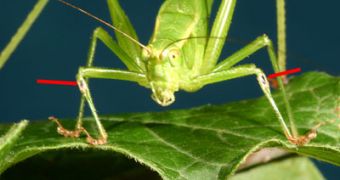A study led by Fernando Montealegre-Z, a sensory biologist at the University of Lincoln, England, shows that, out of strong survival reasons, certain insects have developed an ear structure similar to the one encountered in humans.
Even if the location of the auditory organs is fairly distinct in the two cases, katydids having their ears placed in the bend of their front leg, their auditive capacities are almost the same, Scientific American reports.
Dr. Susan Lawler, head-leader of the Environmental Management and Ecology at La Trobe University, sees the discovery as a revelatory one. Explaining the functionality of the auditory system in insects, she says it is normally distinct from the one we know in humans.
“Hearing in insects is quite diverse. They detect sound through a wide variety of mechanisms, including fine hairs on the outside of their bodies, via structures at the base of their antennae, and occasionally through complex ears that are usually made of a thin cuticle (or tympanum) backed by an air sac to detect vibrations. These ‘ears’ can be located on the thorax, abdomen, legs or wings,” declared Dr. Lawler, as cited by The Conversation.
Apparently, this system doesn't work in katydids' case.
It has been noted that their ear drum, instead of vibrating straight onto the air bag, was activating “a structure that then transferred vibrations to a fluid filled space where receptor cells detect the vibrations,” Dr. Lawler explained.
“This is analogous to the human ear where the eardrum transfers vibrations to a fluid filled space via the tiny bones of the ossicle.”
Scientists say that katydid's highly developed ears make a great defender against their predators. Their ultrasound way of communicating is too high to be heard by the majority of the animals, while their ultra-sensitive ears can easily detect the eventual hunters.
The finding is also seen by researchers as a proof of convergent evolution.
“This discovery shows a remarkable convergence – that is, the evolution of similar structures in unrelated species. The wings of birds and insects are analogous – both allow the animals to take to the air but they evolved along quite different pathways,” Dr. Lawler declared.
“In this case, the transfer of sound has been captured in a similar way in vastly different animals, highlighting the way in which evolution can produce similar solutions to similar problems,” she concluded.

 14 DAY TRIAL //
14 DAY TRIAL //